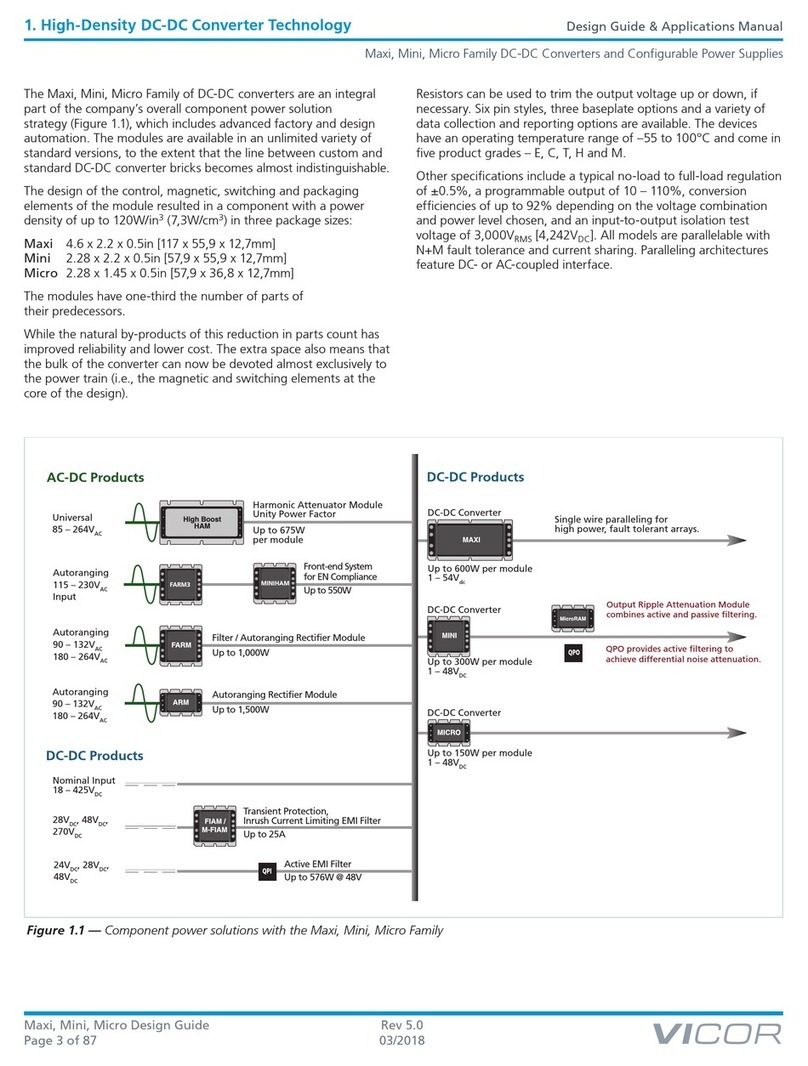
Design Guide & Applications Manual
For VI-200 and VI-J00 Family DC-DC Converters and Configurable Power Supplies
VI-200 and VI-J00 Family Design Guide Rev 3.4 vicorpower.com
Page 4 of 97 Apps. Eng. 800 927.9474 800 735.6200
ELECTRICAL CONSIDERATIONS
GATE IN AND GATE OUT PINS
Logic Disabl . When power is applied to the input pins,
the GATE IN pin of a Driver can be pulled low with respect
to the –IN thus turning off the output while power is still
applied to the input. (Figure 7–1)
CAUTION With offline applications –IN is not
earth ground.
In Logic Disable mode, the GATE IN pin should be driven
from either an “open collector” or electromechanical
switch that can sink 6 mA when on (GATE IN voltage less
than 0.65 V). If driven from an electromechanical switch
or relay, a 1 µF capacitor should be connected from GATE IN
to –IN to eliminate the effects of switch “bounce”. The 1 µF
capacitor may be required in all applications to provide a
“soft start” if the unit is disabled and enabled quickly. Do
not exceed a repetitive on / off rate of 1 Hz to the GATE
IN or input voltage pins.
High Pow r Arrays. The pulsed signal at the GATE OUT
pin of a regulating Driver module is used to synchronously
drive the GATE IN pin of a companion Booster module to
effect power sharing between the Driver and the Booster.
(Figure 7–5) Daisy-chaining additional Boosters (i.e.,
connecting GATE OUT to GATE IN of a succeeding unit)
leads to a virtually unlimited power expansion capability.
VI-/MI-200 series modules of the same family and power
level can be paralleled (i.e., Driver, VI-260-CU with
Booster, VI-B60-CU).
In general:
• Don’t drive the GATE IN pin from an “analog”
voltage source.
• Don’t leave GATE IN pins of Booster modules
unterminated.
• Don’t overload GATE OUT; limit load to a single Vicor
module GATE IN connection, or 1 kΩ, minimum, in
parallel with 100 pF, maximum.
• Don’t skimp on traces that interconnect module –IN
pins in high power arrays. GATE IN and GATE OUT
are referenced to –IN; heavy, properly laid out traces will
minimize parasitic impedances that could interfere with
proper operation.
• Do use a decoupling capacitor across each module’s
input (see Input Source Impedance that follows).
• Do use an EMI suppression capacitor from +/– input and
output pins to the baseplate.
• Do use a fuse on each module’s + input to prevent fire
in the event of module failure. See safety agency
conditions of acceptability for the latest information on
fusing. Please see the Vicor website
for Safety Approvals.
Input Sourc Imp danc . The converter should be
connected to an input source that exhibits low AC
impedance. A small electrolytic capacitor should be
mounted close to the module’s input pins. (C3, Figure 3–1)
This will restore low AC impedance, while avoiding the
potential resonance associated with “high-Q” film
capacitors. The minimum value of the capacitor, in
microfarads, should be C (µF) = 400 ÷ Vin minimum.
Example: Vin, minimum, for a VI-260-CV is 200 V. The
minimum capacitance would be 400 ÷ 200 = 2 µF. For
applications involving long input lines or high inductance,
additional capacitance will be required.
The impedance of the source feeding the input of the
module directly affects both the stability and transient
response of the module. In general, the source impedance
should be lower than the input impedance of the module
by a factor of ten, from DC to 50 kHz.
To calculate the required source impedance, use the
following formula:
Z = 0.1(VLL)2/ Pin
where: Z is required input impedance
VLL is the low line input voltage
Pin is the input power of the module
Filters, which precede the module, should be well damped
to prevent ringing when the input voltage is applied or
the load on the output of the module is abruptly changed.
Input Transi nts. Don’t exceed the transient input
voltage rating of the converter. Input Attenuator Modules
or surge suppressors in combination with appropriate
filtering, should be used in offline applications or in
applications where source transients may be induced by
load changes, blown fuses, etc. For applications where the
input voltage may go below low line it is recommended
that an undervoltage lockout circuit be used to pull GATE
IN low to disable the converter module. The undervoltage
lockout circuit should induce a delay of at least one
second before restarting the converter module. Longer
delays will be required if external capacitance is added at
the output to insure the internal soft-start is re-initialized.
NOTE Do not allow the rate of change of the input
voltage to exceed 10 V/µs for any input voltage deviation.
The level of transient suppression required will depend on
the severity of the transients. A Zener diode, TRANSZORB™
or MOV will provide suppression of transients under 100 µs
and act as a voltage clipper for DC input transients. It may
be necessary to incorporate an LC filter for larger energy
transients. This LC filter will integrate the transient energy
while the Zener clips the peak voltages. The Q of this filter
should be kept low to avoid potential resonance problems.
See Section 14, Input Attenuator Module (IAM/ MI-IAM)
for additional information on transient suppression.
3. Module Do’s and Dont’s




























